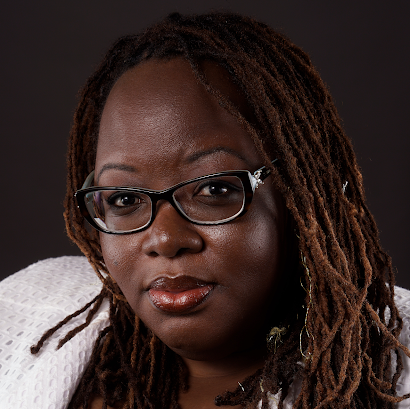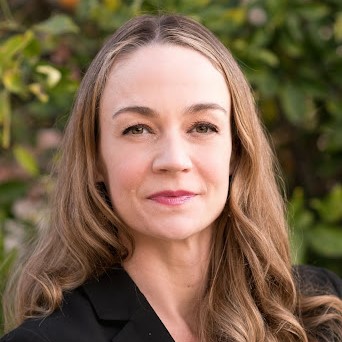Education First is proud to support a group of leading teacher preparation transformation centers (the Centers), technical assistance providers that support teacher preparation programs. The Centers, with the support of Education First, developed the DEI Companion Document to the Teacher Preparation Outcomes and Indicators, a guide to deepening a teacher preparation program’s focus on diversity, equity, inclusion and anti-racism (DEIA). In this three-part blog series, Centers meet with faculty and staff from their teacher preparation program partners to explore the programs’ existing and planned efforts to apply a deeper focus on DEIA, including efforts that are proposed in the DEI Companion Document.
In this third and final blog, Dr. Charlotte Achieng-Evensen, the Senior Transformation Specialist at CalEPIC, and Dr. Meghan Cosier, the Director of the Thompson Policy Institute on Disability at Chapman University, meet with faculty at the University of San Francisco’s School of Education. Throughout the blog, we will include snapshots that highlight how the program is engaging in some of the suggested actions that the DEI Companion Document presents. While every program is on its own unique DEIA journey, we hope this blog offers some learnings and inspires programs to continue the important work to transform teacher education.
The California Educator Preparation Innovation Collaborative (CalEPIC) supports educator preparation programs to prepare a diverse and thriving teaching workforce that focuses on children who have often been traditionally underserved in schools, including students with disabilities, those who are Black, Latinx, LGBTQIA+, as well as those experiencing poverty. We recently met with our colleagues Dr. Patrick Camangian¹, Dr. Shabnam Koirala-Azad² and Dr. Kevin Oh³ at the University of San Francisco’s School of Education. We discussed their ongoing efforts to engage faculty in conversations that challenge institutional norms around research and their work to help teacher candidates consider the experience of disabled students and especially disabled students of color.
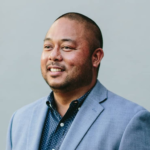
Dr. Patrick Camangian
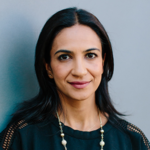
Dr. Shabnam Koirala-Azad
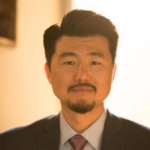
Dr. Kevin Oh
CHARLOTTE: Thank you all for making the time to speak with us today about the School of Education’s efforts to apply a deeper focus on diversity, equity, inclusion and anti-racism, with a particular focus on students of color and students with disabilities. Let’s start with a personal question: Why does diversity, equity, inclusion and anti-racism matter to you, personally and professionally?
SHABNAM: Personally, I possess a third world orientation. I grew up in the third world and immigrated to the US. That experience of transcending borders and boundaries has been a constant in my personal life, and my professional work draws on that experience. Specifically, I think about education as a force for individual, collective and institutional transformation. I seek to better understand ways in which the transformation of self and society can be a function of the types of education we provide and the way in which we understand the foundational purpose of education. And when I think about what that transformation means in the current context, it definitely has to do with the urgencies of our time, everything from anti-Black racism, xenophobia, ongoing attacks against those who have been historically excluded, to a rampant materialism that takes us away from a real understanding of what makes us human.
KEVIN: For me, I often keep my professional work and personal life separate. As an Asian-American with immigrant parents, I was taught to not get into trouble or talk about our struggles. This translates to keeping my personal life out of the classroom. That’s recently changed for me, though, as the culture here changes and as we engage in discussions with CalEPIC about diversity, equity, inclusion and anti-racism. I’m learning how to bring my personal experiences to the classroom. Talking about my experiences as an English language learner and as a student with a difficult home life, helps not only my students grasp the importance of these influences in the classroom, but also helps me as an educator. It’s about allowing our teachers to truly understand who they are and what influence they have when they are teaching students. It’s about the whole child, not just about raising test scores.
PATRICK: When my family immigrated here, we realized early on that they were alienated from the American dream. I therefore disengaged and dropped out of school in the tenth grade because my education was so incongruent with my everyday needs. I turned to the streets for affirmation and a sense of belonging. For me, education is literally a matter of life and death. The deaths of my close friends at the hands of horizontal street violence that came as a result of systemic vertical violence is a direct result of the cultural miseducation they had about themselves as individuals, the communities they were part of, and about the use of violence as the most viable means of solving their problems. We need to provide an education that disrupts hegemonic ideologies that seek to silence their voices, marginalize their image and crush their interests. I try to prepare teachers to be the type of teacher that I wish I had when I was in school.
CHARLOTTE: As you are speaking, I’m seeing the connections between the systemic changes that need to be in place and how educational programs equip us with the skills to make those changes. We know your program has taken very specific steps to apply an explicit focus on diversity, equity, inclusion and anti-racism, with a specific focus on students with disabilities and students of color. How have you done that?
PATRICK: Early on, any racial justice related work, including disability justice, felt like a subversive act. It often felt like a second work shift⁴ rather than something that was embedded in our full time jobs. Despite progressive leadership, our institution continued to acquiesce to the hegemony of Whiteness and to pander to those with privilege. However, when Shabnam became Dean, she shifted our culture to one where efforts to disrupt marginalizations and to engage in intersectional social transformation were required. That was the start of an intentional focus on justice. As part of that intentional effort, we launched the Center for Humanizing Education and Research (C-HER).
“C-HER creates space for faculty to engage each other and come to a better understanding of how we do this research…These are spaces of collective learning, challenging institutional norms around research and bringing people together in conversation around the type of research that is so urgently needed that can lead to policy changes.”—Dr. Shabnam Koirala-Azad
MEGHAN: Can you explain more about C-HER and the role that plays in your school’s effort to apply an explicit focus on diversity, equity, inclusion and anti-racism?
SHABNAM: C-HER promotes the generation, application, and diffusion of high quality, methodologically rigorous research that is conducted in solidarity with local and global communities to address pressing issues through humanizing frameworks. We recognize that research requires a strong and critical analysis of power dynamics and a recognition of how research has been harmful to communities. And, in fact, that research can lead to the generation of new knowledge that can advance our communities. But that hasn’t always been the case. C-HER creates space for faculty to engage each other and come to a better understanding of how we do this research. We design these discussions to be low pressure and low risk. These are spaces of collective learning, for the evolution of thought, challenging institutional histories around research and bringing people together in conversation around the type of research that has implications for changes in practices and policies. C-HER provides a space to engage in the critical reflection necessary for transformative action and imagining something new. Even as we work to dismantle dominant frameworks, we actively contribute to the construction of new humanizing concepts and practices.
MEGHAN: What are some ways you are embedding disability in this justice work?
KEVIN: In the special education department, our focus is on two topics: trauma informed education and an asset-based approach. A lot of times, our teachers go into the classroom and don’t realize the experiences children have at home. They only see bad behaviors. Our goal is to encourage them to reflect on what experiences children might be having at home—for example, are students hungry?—and to take action to create a healthy and safe space for children to learn. Relatedly to an asset-based approach, when working with students with disabilities, it’s important to highlight what students are doing well and the strengths they have with both their parents and their peers.
PATRICK: That’s what is so exciting about being part of the CalEPIC network and having CalEPIC support C-HER. CalEPIC’s framework explicitly addresses students with disabilities and so provides us the resources and support to embed disability justice into our broader justice work. This collaboration with CalEPIC and internally between our teacher education and special education departments is about promoting efforts that focus on the intersectional aspects of diversity, equity, inclusion and anti-racism that center on disability studies and disability justice. Disability is often left out of conversations. We don’t consider what education looks like for disabled students and especially disabled students of color. We’re still in the early stages, but we’re excited to work with CalEPIC to explore how ableism and intersecting systems of oppression show up in our curriculum.
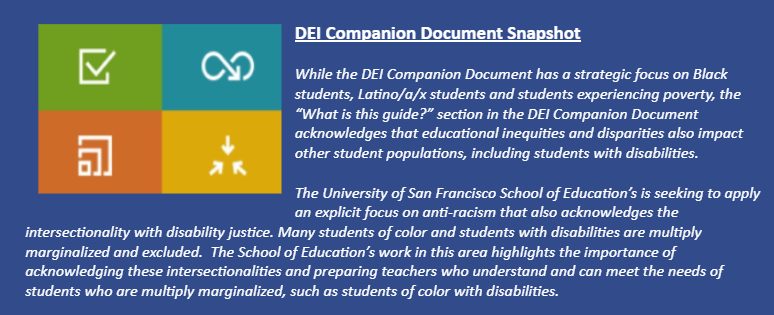
CHARLOTTE: Thank you, and I love how you as a team bring that intersectional lens. Looking forward 3–5 years, what are the policies and approaches that you think are fundamental to shifting the conversation? And, what funding will you seek to support what you’re doing at C-HER and other efforts?
KEVIN: The thing I want to invest more in is how we train our faculty members to create a classroom environment where candidates will be able to talk about these challenging topics. It’s crucial for teacher educators to create a safe enough space where topics of racism in special education can be discussed. Sometimes, teacher educators and teachers unintentionally favor certain students over others. We know there are biases and stereotypes. How do we provide guidance and training to teacher educators to support candidates in reflecting on these things and applying learnings to their practice?
PATRICK: What comes top of mind for me is that funding cuts continue to be made to efforts that promote diversity, equity, inclusion and anti-racism, including in special education. In 3–5 years, I hope we—as a field and country—are committing resources to normalizing a humanizing and intersectional approach to teacher education for preservice and in-serve teachers. We need to invest in recruiting marginalized individuals into this profession, which has historically been one that protects the sensibilities and safety of those with the most privilege. We need to center marginalized voices in policy discussions and use their experiences and knowledge to inform policy development that serves multiple marginalized students. Relatedly, we need to develop a framework for professional development that effectively accounts for the humanity of those who are historically excluded. We also need a policy that pays for that professional development to support teachers in adopting that framework in practice. Finally, we need to establish concrete line items in our budgets for ongoing teacher professional development.
“…we often see funding sources influence the direction of research and other efforts in teacher education and teacher preparation… But, at C-HER, we want to first identify where we want to do work and then find funding sources that align to our vision for that work.”—Dr. Shabnam Koirala-Azad
SHABNAM: Related to funding, we often see funding sources influence the direction of research and other efforts in teacher education and teacher preparation. I often see institutions following the priorities and directions of funders. But at C-HER, we want to first try out some ideas, to move from simplicity to thoughtful complexity and then decide what type of funding would help advance those particular lines of action. Then only do we pursue donors whose vision aligns with our work. Similarly, we value work that stems from authentic experiences and knowledge of micro and macro realities. It is through the evolution of thought, the correlation of ideas to practical experiences, and the testing of these ideas in engaged and meaningful ways that I ultimately see us developing research that has implications for both practice and policy. Generally, C-HER tries to push back against the ways that higher education has historically functioned, like in funding and policy development, and we are seeking to develop a culture where we engage in the generation of new knowledge because we understand it is part of the project of constructing a new reality.
CHARLOTTE: I am absolutely inspired and hopeful. When you talk about funding, there is a wisdom of experience you bring to that conversation that breaks hierarchies and reconstructs how money happens. Our priorities and efforts should be at the behest of intentions, not at the behest of the money. That is radical and encourages a lot of imagination.
MEGHAN: I’ll close by expressing deep gratitude for your time today. The vision moving forward is exciting, and we look forward to continuing our work together to advance a focus on diversity, equity, inclusion and anti-racism, with a focus on the intersection with disability justice. Thank you for your time. We are grateful.
| Resource Center
Below is a list of helpful resources, including those referenced above.
|
This post is the third and final blog in a three-part blog series authored by leading teacher preparation transformation centers—Branch Alliance for Educator Diversity, CalEPIC and CSU Center for Transformational Educator Preparation Programs (CSU CTEPP)—who are working together with other leading transformation Centers to transform the way teachers are prepared. In this series, leaders from these Centers talk with faculty and staff from their teacher preparation program partners about their existing and planned efforts to apply a deeper focus on diversity, equity, inclusion and anti-racism in teacher education. Don’t forget to share the series with your colleagues. We’ll be using #teacherprepmatters to spread the word, and invite you to do the same! Feel free to send comments to info@education-first.com and sign up for our email list.
